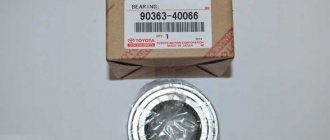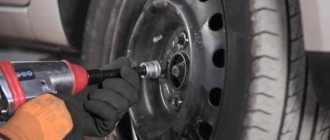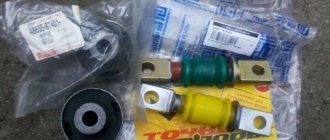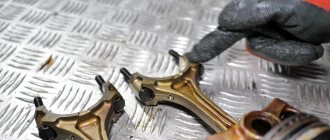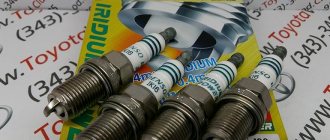It has long been a goal to change the front engine mount, or as it is also called: engine mount or engine mount silent block. For this purpose, I purchased a “Febest TM-PICF pillow” on existential for 755 rubles 66 kopecks, which I later regretted. Photos of the Febest pillow after two months of use are attached. For the first time, the replacement process was carried out with two assistants, which, in principle, did not need to be done; the front engine mount is changed by one person within 20-30 minutes, this includes the preparation time for the replacement process, but more on that later in the article.
When I changed the support for the first time, we unscrewed the front ski on which the cushion is attached and after that we unscrewed the cushion, then we installed a new one and struggled to screw it all back, inserting it into the engine mounting bracket, while one person supported the engine with his back.
This is what happened to the Febest pillow after about two to three months of use. The fastening nut fell off and the rubber part of the cushion bulged to the side. The fact that the rubber jumped out of the support is not scary, but the fact that the nut fell off is already serious. The quality of the German company Febest is very poor. I don’t know the exact production, but it seems to be in China.
Front motor pillow Febest TM-PICF
You can see how the rubber part of the Febest support has bulged
Front engine mount replacement process
As I said, the entire replacement process takes about 20-30 minutes, the entire maintenance process is done with your own hands, no costs to the service station. The tool includes one wrench or a 17mm socket and a screwdriver to pry the bolts off. First of all, we put the car on supports so that there is access from below, the first time I changed it in a pit, since there is no pit in the garage, I had to lift the car in the well-known way, on bars. And from a safety point of view, it will be safer to use bars than to lift with a jack. This time I purchased a replacement “bracket, engine mount Yamato I52072YMT” costing 996 rubles 19 kopecks, all on the same basis. The Yamato company is Japanese, but made in Poland, there is the following inscription: Poduszka silnika wg katalogu TOYOTA, which translated from Polish: Engine mount according to the Toyota catalog. Unfortunately I didn't take any photos, but they look the same.
Next, we jack up the engine; I supported it with a jack through a piece of board into the gearbox. We raise the engine until we can move the engine mount with our hands.
Support the engine with a jack in the gearbox housing
In the repair and operation manual for Toyota Corolla cars, I purchased the book at the same time as buying the car, there are a lot of useful things, I recommend purchasing it too, you can buy it in the online store at a discount. The following is written about replacing the front airbag:
2A Section 15. Clause 13.
To remove the front engine mount, remove the two bolts securing the insulator to the chassis bracket, then remove the three nuts securing the insulator to the chassis.
To be honest, I didn’t understand anything from these instructions and did everything my own way. Unscrew the central bolt securing the support to the engine bracket and pull it out. We unscrew the lower mounting bolts and take out the old pillow. Pulling it out is a little inconvenient; the cooling fan gets in the way. Installing a new cushion is performed in the reverse order. Install and tighten all fastening bolts.
When installing the engine mount, special attention must be paid to its position; one part of the bushing is longer than the other and, accordingly, the engine bracket is also installed offset. If you install it according to the drawing and do not make a mistake, install it crookedly, the front engine mount will quickly fail and pull the rest along with it. So if one of your supports is torn, it is recommended to replace it as soon as possible.
Install the pillow in this position
Replacing the front engine mount 5A-FE in Toyota Corolla 110
This problem has been hanging over the car since the moment of purchase. At the first inspection, cracks were revealed on the surface and, as I remember, there was even a desire to change it. But harsh reality dictated its conditions and I had to forget about replacing the pillow. More precisely, simply come to terms with the increasing vibrations. For a while... A week ago the vibrations became so intense that the massage chair, compared to my car, became just useless nonsense! There is no choice - I ordered the original from my beloved Exist (there were no duplicates at all), which was in a warehouse in Moscow and in 5 days was supposed to be in my hands. Along the way, I also took the original valve stem seals, but I’ll tell you about them in a couple of weeks.
0:1274
1:1779
Here it is, a new pillow
1:1827
2:2332
Truly original...
2:49
I did everything my way. To begin with, I will say that, strictly following the manual, I enthusiastically unscrewed the front “ski” mount and all the parts attached to it from the front. Namely: -Central towing eye
2:433
3:938
-Plastic mudguard and air conditioner tube bracket
3:1036
4:1541
This photo shows where it is located: 1. Mounting the ski to the body 2. Pin of the air conditioner bracket 3. The actual lower mounting of the cushion 4. Towing eye
4:1842
5:2347
Then I looked at the rear mount and the enthusiasm evaporated, as if it had never existed. I decided to pull out the old pillow without removing the beam. Unscrewed the bolt holding the pillow to the bracket
5:325
6:830
Somehow I managed to pull the pillow up. The rigidity on the Carlson casing was very annoying, but the plastic there is quite flexible and I managed to bend it to the side. Reassembled in reverse order. First, I stuffed a new pillow with mats, tightened the central bolt, then tightened the bottom two and heartily tightened the central one again. I put everything back in place and here is the result
6:1518
7:2023
Well, the old pillow went to live temporarily on the shelf. Then it will be washed, cleaned and sent to Novosibirsk to Polyurethane LLC. Let it be restored with polyurethane.
7:301
8:806
9:1311
10:1816
Vygal looked at the engine and did not understand one thing. When switching to D, the engine leans toward the passenger compartment. I understand - torque and all that, but isn't this a sign of a dead rear cushion? As I understand it, if they die, they die together, and they must be changed, accordingly, also in pairs.
10:2349
https://www.drive2.ru/l/288230376152163617/
10:46 next article:
Engine 3A in Toyota Corolla
The A Series is a family of 1.3 to 1.8 liter inline 4-cylinder engines manufactured by Toyota Motor Corporation. Development
11:850
Rating 0.00 [0 Vote(s)]
15755
Engine balancing after replacing pillows
After replacing the pillow, it is necessary to balance the engine. The engine mounting bracket has free movement vertically and it is necessary to unload and distribute the load on the remaining supports. Therefore, when tightening the bolts, tighten the central bolt of the support without force. After this, we start the engine and let it run until the engine warms up. You can now remove the car from the supports and move forward and backward. After this, let the engine run a little more, then turn off and tighten the bolt with force. Access to the bolt will already be through the hood from above if you lower the car.
That's basically all, a small guide to servicing your car, with your own hands, without contacting a technical service. If you have questions, ask in the comments. And don't forget to bookmark the site and subscribe to updates.
Engine mount Toyota Corolla
Toyota Corolla engine support can be mechanical or hydraulic. The Toyota Corolla engine mount can be assembled with a bracket or separately, depending on the engine size and type of gearbox. The engine is mounted on three or four supports, depending on the engine size.
A hydraulic engine mount for a Toyota Corolla is always more expensive than a mechanical one. In some cases, on the mechanical support of the internal combustion engine, it is possible to replace a separate silent block of the pillow. It is pressed out and a new one is pressed in. This is usually done if the pillow is torn, but the bracket itself is not broken or bent. The service life of an engine mount is on average 5 to 7 years of moderate use. High power engines may have a shorter service life.
Toyota Corolla engine mount price:
| Engine support options | Price | Buy |
| Toyota Corolla engine mount, rear | from 1500 rub. | |
| Toyota Corolla engine mount, front | from 1200 rub. | |
| Toyota Corolla engine mount, left | from 850 rub. | |
| Toyota Corolla engine mount, right | from 850 rub. | |
| Toyota Corolla engine mount, upper | from 1100 rub. | |
| Toyota Corolla engine mount, lower | from 1100 rub. | |
| Toyota Corolla engine mounting bracket | from 700 rub. | |
| Toyota Corolla engine mount silent block | from 400 rub. |
Do you want to buy an engine mount with a profit of up to 30%? Call or write to us right now!
Phone: 8 (812) 409-46-75
Write to us on Whatsapp
The cost of an engine mount (mount) depends on whether it is new or used, the condition of the used one (cracks, deformation, etc.), the manufacturer, as well as on availability in our warehouse or delivery time before our store
Before purchasing a Toyota Corolla engine support, you must first make a diagnosis and determine which specific support has failed. Do not delay replacing the engine mount. A faulty mount can lead to engine and transmission failure.
The main signs of a faulty engine mount:
— the pillow is torn; — strong vibration of the car transmitted to the body; — strong vibration of the engine and gearbox.
Toyota Corolla engine mount rating based on owner reviews:
1. Original support 2. Lemforder (Germany) 3. Ruville (Germany) 4. Febi (Germany) 5. Febest (Germany)
For engine
- 1.6 CVT (122 hp)
- 1.6 MT (122 hp)
- 1.8 CVT (140 hp)
- 1.33 MT (99 hp)
- 1.4 MT (97 hp)
- 1.4 D-4D MT (90 hp)
- 1.6 MT (110 hp)
- 1.8 MT (192 hp)
- 1.8 Supercharged MT (225 hp)
- 2.0 D-4D MT (116 hp)
- 1.6 AT (110 hp)
- 1.8 Supercharged MT (218 hp)
- 2.0 D-4D MT (90 hp)
- 1.3 AT (88 hp)
- 1.3 MT (88 hp)
- 1.6 AT (115 hp)
- 1.6 MT 4WD (115 hp)
- 2.0 D MT 4WD (73 hp)
- 1.5 AT (100 hp)
- 1.5 MT (100 hp)
- 1.6 AT 4WD (115 hp)
- 1.6 MT (115 hp)
- 2.0 D AT (73 hp)
- 2.0 D MT (73 hp)
- 2.0 D-4D MT (110 hp)
- 1.8 3AT (120 hp)
- 1.8 MT Overdrive (120 hp)
- 1.8 4AT (120 hp)
- 1.8 3AT (125 hp)
- 1.8 4AT (125 hp)
- 1.8 MT Overdrive (125 hp)
- 1.2 Synchromesh (69 hp)
- 1.2 Synchromesh (74 hp)
- 1.2 Synchromesh (78 hp)
- 1.4 Synchromesh (91 hp)
- 1.4 Synchromesh (87 hp)
- 1.3 MT (75 hp)
- 1.6 MT (114 hp)
- 2.0 D MT (72 hp)
- 1.3 MT (86 hp)
- 1.6 MT Overdrive (100 hp)
- 1.6 AT Overdrive (100 hp)
- 1.6 MT Overdrive (102 hp)
- 1.6 AT Overdrive (102 hp)
- 1.5 AT (105 hp)
- 1.5 MT (105 hp)
- 1.6 AT (105 hp)
- 1.6 MT Overdrive (105 hp)
- 1.3 AT (100 hp)
- 1.3 MT (100 hp)
- 1.6 AT (160 hp)
- 1.6 MT (160 hp)
- 1.6 AT (100 hp)
- 1.8 AT (105 hp)
- 1.8 AT (115 hp)
- 1.8 MT Overdrive (105 hp)
- 1.8 MT (115 hp)
- 1.3 AT (97 hp)
- 1.3 MT (97 hp)
- 1.6 AT (140 hp)
- 1.6 MT Overdrive 4WD (100 hp)
- 1.3 AT (75 hp)
- 1.6 MT Overdrive (90 hp)
- 1.6 AT Overdrive 4WD (100 hp)
- 1.6 AT (90 hp)
- 1.8 D MT (64 hp)
- 1.8 D MT (67 hp)
- 1.5 AT (94 hp)
- 1.5 AT (85 hp)
- 1.5 MT (85 hp)
- 1.5 MT (94 hp)
- 1.6 AT (102 hp)
- 1.6 AT Overdrive (90 hp)
- 1.6 AT Overdrive 4WD (102 hp)
- 1.6 MT Overdrive 4WD (102 hp)
- 1.6 MT (96 hp)
- 1.6 MT (117 hp)
- 1.6 MT (140 hp)
- 1.8 D AT (67 hp)
- 1.8 D AT (64 hp)
- 1.3 MT (69 hp)
- 1.6 AT (70 hp)
- 1.6 MT (91 hp)
- 1.6 MT (86 hp)
- 1.8 D MT Overdrive (58 hp)
- 1.5 MT (83 hp)
- 1.6 MT Overdrive (70 hp)
- 1.8 D AT (58 hp)
- 1.6 AT 4WD (110 hp)
- 1.6 AT (165 hp)
- 1.6 6MT (165 hp)
- 1.6 5MT (165 hp)
- 1.6 MT 4WD (110 hp)
- 2.2 D AT (79 hp)
- 2.2 D MT (79 hp)
- 1.3 AT (73 hp)
- 1.3 MT (73 hp)
- 1.3 MT (70 hp)
- 1.6 MT (121 hp)
- 1.3 MT (60 hp)
- 1.8 MT Overdrive (75 hp)
- 1.3 AT (60 hp)
- 1.8 AT (75 hp)
- 1.8 Synchromesh (75 hp)
- 1.6 AT (120 hp)
- 1.6 MT (120 hp)
- 1.5 AT 4WD (105 hp)
- 1.5 AT (109 hp)
- 1.8 AT 4WD (125 hp)
- 1.8 AT (190 hp)
- 1.8 MT (190 hp)
- 1.5 MT (109 hp)
- 1.8 MT (136 hp)
- 1.8 AT (132 hp)
- 1.8 MT Overdrive (115 hp)
- 1.1 Toyoglide (64 hp)
- 1.1 Toyoglide (60 hp)
- 1.1 Synchromesh (60 hp)
- 1.1 Synchromesh (64 hp)
- 1.1 Synchromesh (73 hp)
- 1.3 AT (87 hp)
- 1.3 MT (87 hp)
- 1.5 AT (110 hp)
- 1.5 MT (110 hp)
- 1.8 AT (136 hp)
- 1.5 AT 4WD (110 hp)
- 1.8 AT (130 hp)
- 1.8 AT (126 hp)
- 1.8 5MT Overdrive (130 hp)
- 1.8 6MT Overdrive (170 hp)
- 1.8 6MT Overdrive (164 hp)
- 1.8 5MT Overdrive (126 hp)
- 1.3 AT (85 hp)
- 1.3 MT (85 hp)
- 1.6 MT (165 hp)
- 1.8 MT Overdrive (70 hp)
- 1.6 AT Overdrive (70 hp)
- 1.8 AT Overdrive (70 hp)
- 1.2 MT (56 hp)
- 1.3 MT (58 hp)
- 1.6 AT (76 hp)
- 1.6 MT (76 hp)
- 1.6 MT Overdrive (76 hp)
- 1.5 CVT FWD (109 hp)
- 1.5 CVT AWD (103 hp)
- 1.5 Hybrid CVT (74 hp)
- 1.3 CVT (95 hp)
- 1.6 (122 hp) manual transmission
- 1.6 (132 hp) manual transmission for Europe
- 1.6 (132 hp) CVT (for Europe)
- 1.6 (122 hp) CVT
- 1.2 MT (116 hp)
- 1.2 CVT (116 hp)
- 1.2 CVT AWD (116 hp)
- 1.8 Hybrid CVT (98 hp)
- 2.0 MT (168 hp)
- 2.0 Hybrid CVT (153 hp)
- 2.0 CVT (168 hp)
- 3 (101 hp)
- 1.4 (97 hp)
- 1.5 (110 hp)
- 1.6 (124 hp)
- 1.8 (132 hp) gasoline
- 2.0 (132 hp) diesel
- 1.8 (132 hp) gasoline, manual transmission, front-wheel drive
- 1.8 (132 hp), gasoline, automatic transmission, front-wheel drive
- 1.8 (132 hp), gasoline, variator (CVT), front-wheel drive
- 1.8 (140 hp), gasoline, CVT, front-wheel drive
- 1.6 4WD AT (145 hp)
- 1.6 4WD MT (145 hp)
- 1.8 4WD D AT (64 hp)
- 1.8 4WD D MT (64 hp)
Modifications
- Toyota Corolla E170 (11th generation)
- Toyota Corolla E15
- Toyota Corolla E210
- Toyota Corolla E10
- Toyota Corolla E20
- Toyota Corolla E50 restyling
- Toyota Corolla E70 restyling
- Toyota Corolla E100
- Toyota Corolla E80
- Toyota Corolla E110 restyling
- Toyota Corolla E120
- Toyota Corolla E170 restyling
- Toyota Corolla E70
- Toyota Corolla E90
- Toyota Corolla E110
- Toyota Corolla E130 restyling
- Toyota Corolla E160

